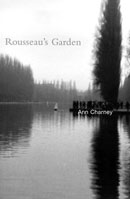
Rousseau’s Garden
Ann Charney
Véhicule Press
$18.95
paper
206pp
1-55065-146-3
Ann Charney is interested in character and ideas, neither of which is particularly well served by the mantra of “show, don’t tell” that brings far too many writers and readers to their knees. With a backwards nod to the narrative traditions of Flaubert and Henry James, a sideways glance to the voiceover conventions of European cinema, and a bold step forward to a time when the face of fiction is less troubled by Hollywood’s “values,” Rousseau’s Garden tells its readers a great deal about the complexities of character and the subtleties of ideas that arise when marriage, parenthood, friendship and love are at odds.
Claire Symons has traveled to France from Montreal to be with her art historian husband Adrian Arensberg while he researches a book on French gardens. Claire is Adrian’s young second wife and a stepmother to his teenage daughter, but she isn’t a mere adjunct or trophy. Claire is a professional photographer with her own connections to France. Dolly, Claire’s mother, was a Cégep art teacher and sculptor who had been a regular visitor to Paris with and without her daughter. On a last visit to France before her untimely death in a street accident, something happened to Dolly that changed her as wife, mother, and artist. Now the age her mother was then, Claire seeks to recover from her own anxieties by retracing Dolly’s last journey. She visits her mother’s friends and favourite places in Paris and the nearby countryside. She also rereads her mother’s favourite writer – the eighteenth century philosopher Jean Jacques Rousseau.
Rousseau’s exaltation of nature provided her with the esthetic impulse to redefine her work as a sculptor. Claire could almost recite Dolly’s explanations by heart: she had grown dissatisfied with her early representational figures. Rousseau’s work had inspired her treks into the countryside where she sketched natural forms, translating them later into her studio into abstract geometric solids. Claire showed Adrian a statement Dolly had prepared for an exhibition in which she wrote, “With Rousseau as my guide I perceived the energy and movement inherent in each form of nature.”
As Claire meditates on Rousseau and photographs the grounds of a crumbling chateau that are “said to be the work of André Le Nôtre, the greatest of French gardeners, who designed the gardens at Versailles,” she is “shadowed by invisible presences…linked through her consciousness like figures in a dance.” These invisible presences do not persecute her as they persecuted Rousseau. Rousseau fled from his ghosts into the invention of “imaginary worlds where friends were loyal, women tender, and merit rewarded.” In Claire’s case, they lead her to create photographs in which, as the owner of the garden says, “Everything appears as it is, quite ordinary at first glance. Yet each scene is pervaded by a feeling of loss, a reminder of the perishable nature of all gardens. It’s as if she had read my heart.”
Ann Charney creates a similar effect with her words. Her characters are quite ordinary at first glance (at least to middleclass Montrealers) but each is pervaded by even more ordinary losses in marriage, parenthood, friendship, and love. But like Claire, Charney is a sorcerer who enables you to find your own reflection in her images if you are willing to meet the demands of her aesthetic rather than impose your own. What I like about her work here as well as her earlier novel Dobryd – and most of all in Defiance in Their Eyes: True Stories from the Margins, an unacknowledged Canadian classic – is her uncanny ability to connect the inner visions of her subjects with their outward realities. She shows us, as few do, that Montreal is as beautiful as it is not simply because Montrealers have good genes and eat well but because more than a few among us know what kinds of mirrors to hold up to the rest. mRb






0 Comments